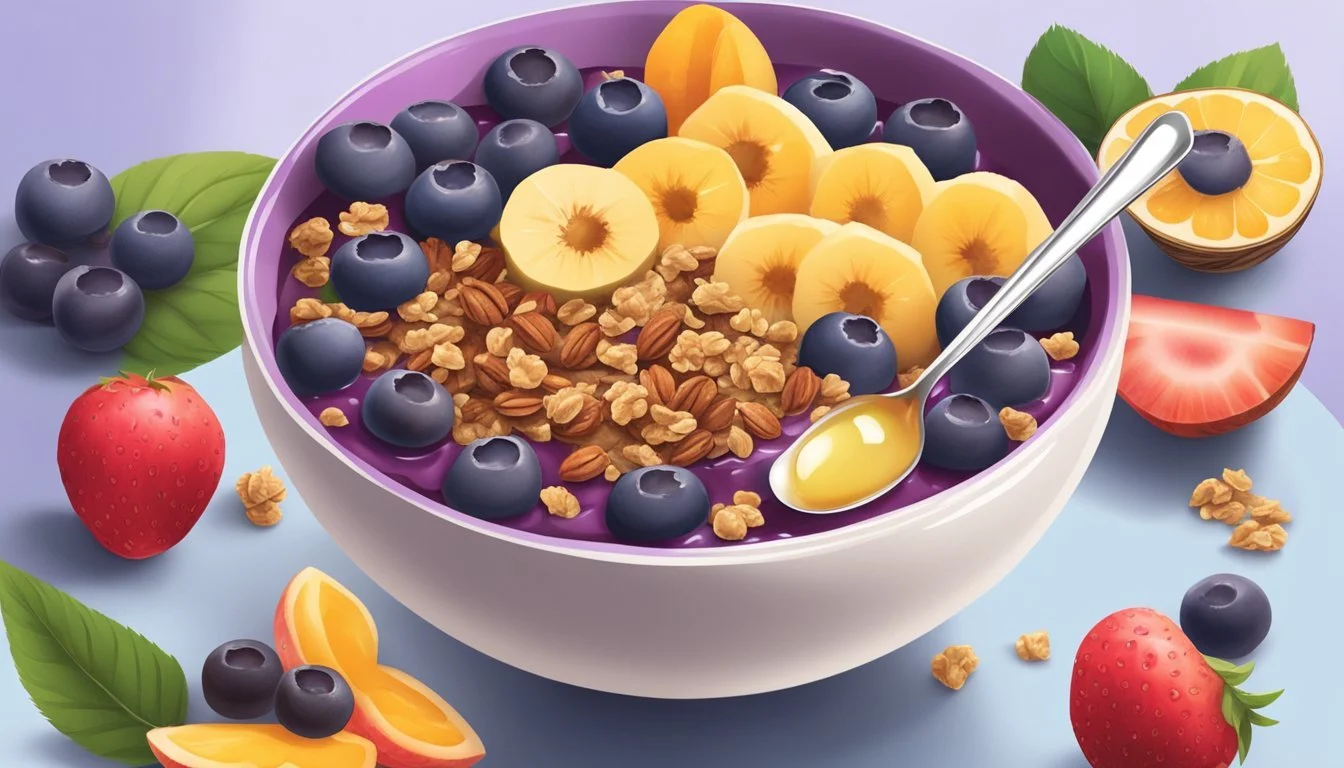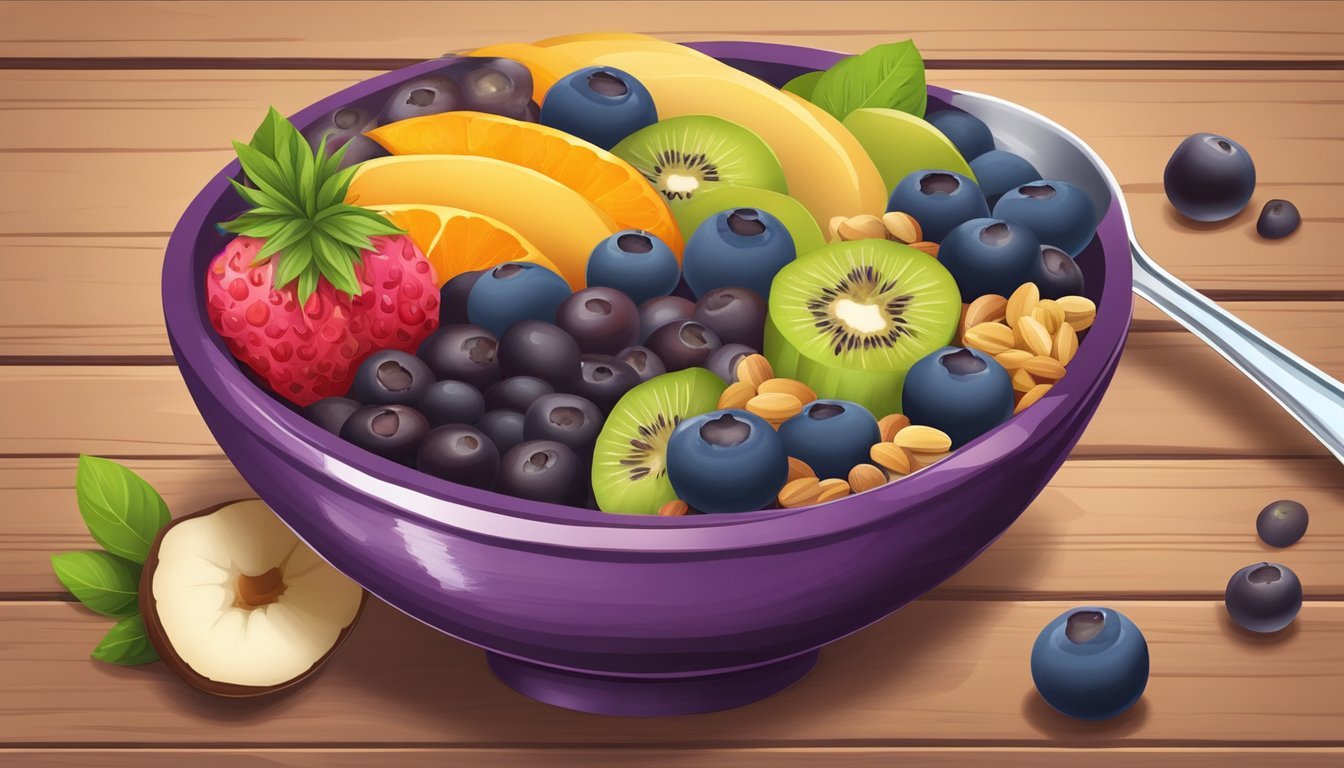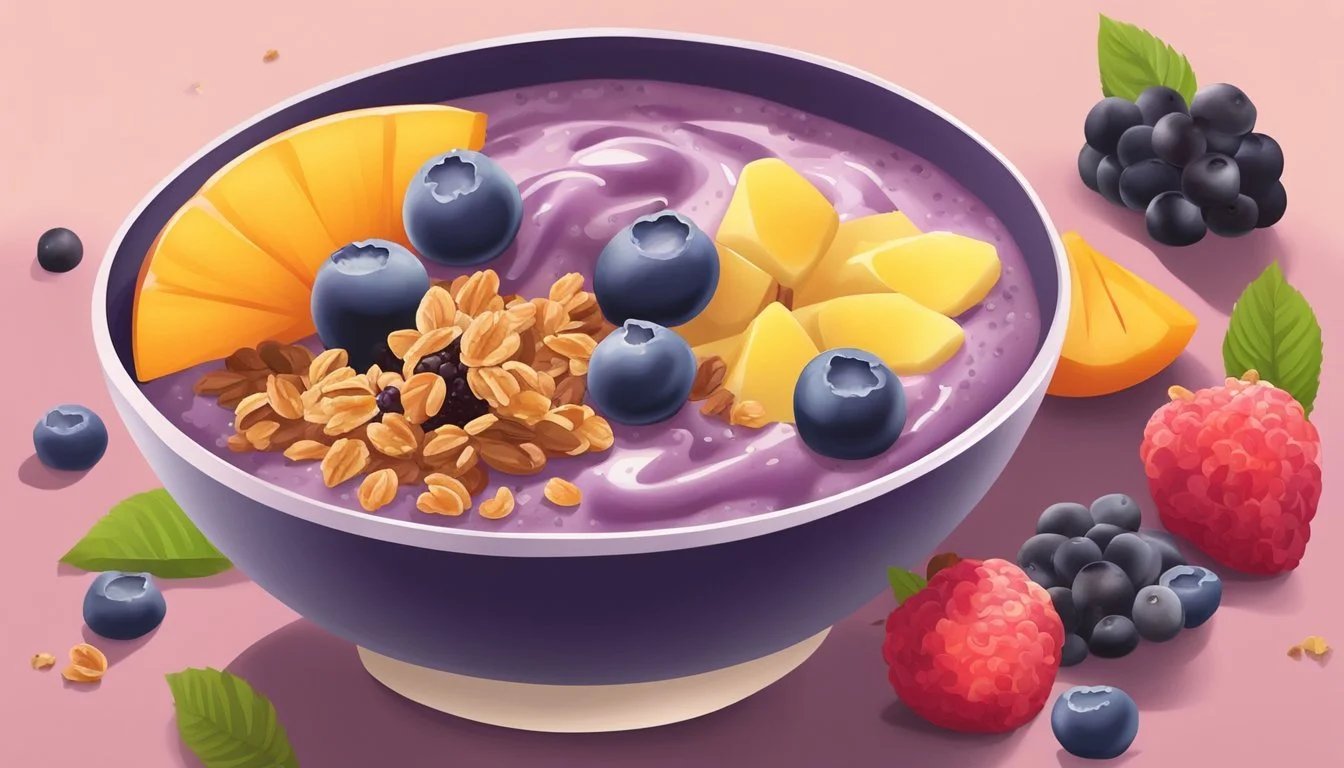How do you eat an acai bowl?
Unveiling the Best Techniques for Enjoying this Superfood
Acai bowls are a popular dish that blends the nutritious benefits of acai berries (how long do acai berries last?) with the pleasure of a dessert-like meal. They typically consist of frozen acai berry puree topped with a variety of fresh fruit, nuts, seeds, and a sweet drizzle of honey or syrup. This Brazilian specialty offers a unique taste that can be described as a mix of wild berries with subtle hints of chocolate, making it not only a treat for the palate but also a visually appealing meal.
Consuming an acai bowl is straightforward and requires no cooking. Individuals can enjoy this dish for breakfast, as a snack, or even as a lighter meal option. Its composition is simple: the base is made from acai puree or a blend that may contain additional ingredients like guarana, and the toppings can vary based on personal preference. The versatility and ease of preparation contribute to the growing popularity of acai bowls around the world.
What Is an Acai Bowl?
An acai bowl is a dish rich in nutrients and antioxidants centered around the pureed fruit of the acai berry. It often serves as a base for a variety of toppings and embodies both a flavorsome and nutritious eating experience.
Origin of Acai Bowls
The acai bowl traces its roots to Brazil, where the acai palm is native, specifically in the Amazon region. Acai (pronounced ah-sah-EE) bowls began as a local delicacy, consumed for its nourishing properties. The use of acai berries in these bowls has expanded globally due to their classification as a superfood.
Nutritional Profile
Acai berries are valued for their high levels of antioxidants, comparable to other berries such as blueberries and cranberries. They also contain essential vitamins and minerals, contributing to their esteemed nutritional value. Acai is low in sugar, but high in fiber, which aids in digestion.
Table: Nutritional Value of Acai Berries (per 100g)
Nutrient Value Antioxidants High concentrations Fiber Approximately 2g Vitamins Vitamin A, Vitamin C Sugar Low
Key Components of an Acai Bowl
The acai bowl's foundation begins with acai puree or frozen acai packets. This puree can be made from acai powder blended with water or juice for a smoother texture. These bases are either machine-blended or hand-stirred until they reach a thick consistency similar to that of a smoothie. Once prepared, the acai base is adorned with an array of toppings such as fresh fruits, granola, and honey, thus completing the acai bowl.
Preparing the Base
The foundation of an acai bowl is a thick and creamy base, typically made with acai and frozen fruit blended to a smooth consistency. Achieving the perfect base involves selecting quality acai and pairing it with the right liquid and complementary frozen fruits.
Choosing the Right Acai
Acai comes in various forms, including puree, powder, and whole berries. Frozen acai packets deliver a concentrated flavor and are often preferred due to their convenience and consistency. When unavailable, acai powder can also be utilized by blending it with frozen fruit to achieve a similar texture. The goal is to use acai that's deep in color and rich in taste.
Selecting a Liquid
The right liquid is key to blending a smooth base without making it too runny. Options include:
Juice: Adds natural sweetness and can complement the berry flavors.
Milk: Creates a creamier texture. Dairy or non-dairy milk like almond milk can be used based on preference.
Using a high-speed blender, add the liquid cautiously. It's easier to add more liquid as needed than to correct an overly thin base.
The Role of Frozen Fruit
In addition to acai, frozen fruit contributes to the desired thickness and adds natural sweetness to the base. Common choices are frozen blueberries, strawberries, and bananas (how long do bananas last?). These fruits should be blended with the acai until no chunks remain, resulting in a smooth and spoonable consistency.
Building Flavors and Nutrition
Creating a nutrition-packed acai bowl is a fine balance between flavor and health benefits. Choosing the right combination of fruits and proteins, while managing sweetness, can greatly boost the nutrient profile.
Incorporating Fruits
Fruits not only add natural sweetness and flavor but are also rich in vitamins, minerals, and fiber. Bananas, with their high potassium content, make for a creamy base in acai bowls. Blueberries and mango provide a rich source of vitamin A and C, as well as antioxidants such as anthocyanins. Kiwi, which is high in vitamin C, and coconut, offering healthy fats, can be used to enhance the flavor and nutrient content. Here is a list of popular fruit additions that contribute to the overall nutritional value:
Banana: Adds creaminess and natural sweetness, rich in potassium.
Mango: High in vitamin A; adds tropical flavor.
Kiwi: Vitamin C powerhouse.
Blueberries: Known for their antioxidant properties and high in vitamin C and K.
Fresh Berries: A mix can provide a wide range of nutrients and flavors.
Adding Protein and Fats
To balance the carbohydrates from the fruits, incorporating protein and healthy fats is essential. Nut butters such as almond or peanut butter add richness while offering healthy fats and protein. Seeds like chia seeds or flaxseeds contribute not only protein and omega-3 fatty acids but also vital minerals like calcium and iron. Nuts such as almonds or walnuts can be sprinkled on top for added texture and nutrients. Here are some protein and fat options:
Nut butters (Almond butter, Peanut butter): Healthy fats and protein, adds creamy texture.
Seeds (Chia seeds): Source of protein, omega-3s, calcium, and iron.
Nuts: For crunch and added protein, healthy fats.
Considerations for Sweetness
While fruits add natural sugars to an acai bowl, additional sweeteners should be used sparingly. Honey can be drizzled for extra sweetness, but it's important to be mindful of the added sugars. Unsweetened acai puree is preferable as a base to control the overall sugar content. Smoothie bowls often rely on the natural sweetness of their components, but here are low-sugar options for those who prefer a sweeter taste without the sugar spike:
Honey: Natural sweetener; use in moderation.
Added sugars: Best to avoid or use minimal amounts if necessary.
Sweetener selection: Always opt for natural and low-glycemic index options.
By carefully selecting the ingredients based on their nutritional value, one can build an acai bowl that is not only flavorful but also a healthy option for any meal of the day.
Enhancing the Acai Bowl
When crafting the perfect acai bowl, the texture and choice of toppings are crucial for an indulgent experience. The goal is to achieve a creamy base with a variety of toppings that offer complementary flavors and a satisfying crunch.
Texture and Consistency
The secret to a perfectly creamy acai bowl lies in the base ingredients and preparation technique. A high-speed blender is essential for creating a smooth mixture, where frozen acai pulp is combined with frozen fruit, such as blueberries and bananas, to create thickness. For added creaminess, one can incorporate milk or a dollop of yogurt. Using a tamper with the blender helps to uniformly crush and mix the ingredients, ensuring the desired consistency—thick enough to support the weight of the toppings without becoming soupy.
Top Toppings Selection
A well-curated selection of toppings enhances both the flavor and the visual appeal of an acai bowl. Here are some top picks:
Granola: Offers a satisfying crunch and wholesomeness.
Fresh Fruit: Sliced banana, blueberries, and other fruits add natural sweetness.
Seeds & Nuts: Chia seeds, chopped nuts, or even a sprinkle of hemp seeds give a nutrient boost and added texture.
Coconut: Shredded coconut lends a tropical flair and chewiness.
Chocolate: A sprinkle of cacao nibs can add a rich, chocolatey crunch without overt sweetness.
By balancing these elements, one can create an acai bowl that is not only nutritious but also a delight to the senses.
Serving and Consumption
Acai bowls are a versatile dish that can be enjoyed as both a nutritious breakfast or a delightful dessert. Their preparation and consumption can affect the experience of eating them.
Ideal Serving Conditions
The acai bowl is best served chilled. It should be composed of a thick blend of frozen acai berries, often mixed with other fruits, and topped with a variety of ingredients such as sliced fruit, granola, coconut flakes, and a drizzle of honey. The ideal serving temperature is just above the freezing point, which ensures the bowl is refreshingly cool but not too solid to eat comfortably with a spoon. Acai bowls are often found in 8 oz. and 16 oz. servings. Each person should select the portion size that aligns with their nutritional needs and appetite.
Eating Techniques
When consuming an acai bowl, it's commonplace to use a spoon. One can start by mixing the toppings into the base, allowing for a blend of textures and flavors with each bite. Taking spoonfuls from different sections can also vary the taste experience, as each bite may include different combinations of the toppings. As an alternative, one can savor the toppings first and gradually work their way down to the acai puree. For those on the go, converting the acai bowl into a smoothie by blending it allows for easy consumption and enjoyment of the same flavors in liquid form.
Variations and Customizations
Eating an acai bowl is a customizable experience, allowing individuals to tweak recipes to meet dietary needs and indulgence in creative flavor profiles.
Dietary Adaptations
For those adhering to specific dietary restrictions, acai bowls offer flexible options. Here are adaptations for common dietary preferences:
Vegan: Replace traditional dairy with plant-based milks such as almond, coconut, or hemp milk. Vegan yogurt or protein powders can add creaminess and nutrients.
Gluten-Free: Acai bowls are naturally gluten-free. However, one must ensure that any added granolas or toppings are certified gluten-free to avoid contamination.
Dairy-Free: Like vegan variations, dairy can be substituted with various non-dairy milks and yogurts available in the market.
Creative Combinations
Creating a homemade acai bowl presents an opportunity to explore a variety of flavors and textures. Below are components that can be mixed and matched:
Fruits: Bananas, strawberries, and blueberries are common. However, one can also incorporate mango, pineapple, or cherries for a twist.
Proteins: Add proteins like Greek yogurt, nut butters, or protein powders to increase satiety and nutritional value.
Toppings: Granola, chia seeds, coconut flakes, and cacao nibs provide crunch and nutrients. Sweeteners like honey or agave can be drizzled for added sweetness.
By combining these elements, individuals can craft a personalized acai bowl that caters to unique tastes and dietary needs.
Health and Dietary Considerations
When incorporating acai bowls into one's diet, consumers should be aware of the nutritional content, particularly sugar levels, and allergens that could affect individuals with specific dietary restrictions.
Sugar Content and Substitutes
Sugar: Acai bowls often contain natural sugars from the acai berry and added sugars from toppings like fruits and granola. A typical 6-ounce acai bowl may have approximately 19 grams of sugar. Excess sugar intake can lead to health issues such as weight gain and increased acid production, which might affect tooth enamel.
Substitutes:
Natural Sweeteners: To reduce sugar content, one can opt for natural sweeteners like honey or agave nectar in moderation.
Low-Sugar Toppings: Incorporating toppings with lower sugar content, such as nuts or seeds, provides healthy fats and protein without significantly increasing the sugar level.
Allergen Information
Common Allergens in Acai Bowls:
Nuts: Frequently used as toppings, nuts are a common allergen. Individuals with nut allergies should opt for alternate toppings like chia seeds to provide protein and healthy fats without the risk.
Dairy: Some acai bowl recipes may include dairy products. For those with lactose intolerance or dairy allergies, dairy-free alternatives like almond or coconut milk are advisable.
It is important for consumers to understand the potential allergens present in acai bowls to avoid adverse reactions. Those with concerns should carefully select their toppings or consult nutrition labels when purchasing premade options.
The Cultural Impact of Acai Bowls
As acai bowls transitioned from Brazilian specialty to global health food trend, they carved a significant niche in popular culture and brought to light discussions on sustainability and ethical sourcing of the acai berry, a fruit native to the Amazon rainforest.
Acai Bowls in Popular Culture
Acai bowls have made a splash in popular culture, largely due to their vibrant appearance and perceived health benefits. They are often featured on social media platforms, where influencers and health enthusiasts showcase their colorful concoctions topped with an array of fruits, nuts, and seeds. This visual appeal, combined with the health-conscious narrative associated with acai bowls, has cemented their status as a fashionable food choice. Moreover, many celebrities and fitness professionals have endorsed acai bowls, further propelling their fame and aligning them with a lifestyle that values well-being and mindful eating.
Sustainability and Ethical Sourcing
The rising popularity of acai bowls has raised questions about sustainability and ethical sourcing, especially given the acai berry's origins in the Amazon rainforest. Sustainability efforts focus on ensuring that the demand for acai does not lead to deforestation or negative environmental impacts. Ethical sourcing encompasses fair trade practices that guarantee fair compensation and working conditions for local harvesters. Companies and suppliers are increasingly seeking certifications to confirm that their acai products support the well-being of the environment and the communities that depend on the acai palm for their livelihoods. This responsible approach helps preserve the Amazon and its resources for future generations while providing consumers with a product they can enjoy with a clean conscience.
Conclusion
Eating an acai bowl is a delightful experience that combines nutrition and versatility. They can be enjoyed as a breakfast item, a post-workout snack, or simply as a refreshing treat. With their fiber-rich and heart-healthy fat content, acai bowls support both digestion and cardiovascular health.
Customization is key with acai bowls, allowing individuals to tailor them to their dietary preferences and nutritional needs. Whether adding a variety of fresh fruits, a scoop of protein powder, or a drizzle of honey, each bowl can be unique to the consumer's taste.
For those mindful of their sugar intake, particularly if weight management is the goal, selecting unsweetened acai and topping with natural sweeteners like fresh fruit can be beneficial. Acai's relatively low calorie count per serving makes it an attractive option for a nutritious meal component.
Consumers don't need to consume an entire acai bowl in one sitting. Acai bowls are just as enjoyable when saved for later, making them a convenient option for a healthy snack.
It is noteworthy that when consuming commercially prepared acai bowls, one should be cognizant of the potential for added sugars, especially in blends that might taste sweeter.
In summary, acai bowls offer a customizable, nutritious eating option for a variety of occasions. Their flexibility and health benefits make them a staple for those seeking a delicious and health-conscious meal choice.









